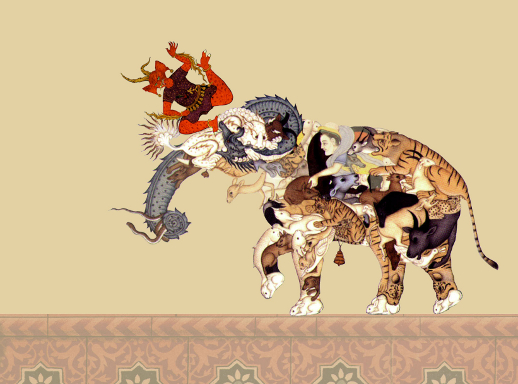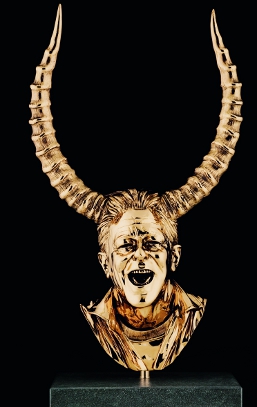Tokyo Transformers
There are two main coup de exhibition in the Museum of Contemporary Art’s “Transformation” show. The first happens near the start when, if you follow the suggested route, you emerge from Tunga’s eerie video of cats into the main third floor space, a massive hall alive with vivid and grotesque works.
The second arresting moment occurs when you leave the first floor and are nearing the end of the exhibition. A black curtain drapes across the entrance and you think you are going to encounter yet another video work, but instead come face-to-face with two rows of head sculptures. Jan Fabre’s remarkable busts all subvert convention, laughing and grinning faces with outlandish horns.

This is a typical “transformation” — of shape and form, of genre, of expectation. Given the theme of the show it is no surprise that it begins with a small creature seemingly snatched from the off-cuts of one of those biological exhibits like “Body Worlds”. Patricia Piccinni’s pig-like ‘thing’ is deformed, ugly — but challengingly cute too. Other inclusions like Motohiko Odani, Bharti Kher and Lee Bul do not surprise given the title.

It is great to see so much Asian and overseas work in Tokyo. A highlight of this is Matthew Barney’s mammoth ‘Cremaster Cycle’, shown on two back-to-back screens. Unfortunately it will prove impossible to watch the whole work, not least due to its daunting length but the fact that it is played in the middle of a room with no seating. Visitors mill around, trying to make sense of Barney’s bizarre magnum opus.
It’s not all gothic and bestial transformations, though. Naoki Ishikawa’s large C-print photos of Artic wasteland reveal new facades to our planet. And Marcus Coates and the multi-talented Sputniko! bring humour and colour to the selection.
There are, however, a lot of video works, often one after the other, and with neighboring piece’s soundtracks sometimes distractingly audible. By the time you reach Apichatpong Weerasethakul’s odd and anti-climatic film set in an Thai natural park fatigue may well have set in. This is a pity as the atrium works are striking, not least Bharti Kher’s animal vacuum cleaner and Simon Birch’s hypnotic video installation eulogizing the dangerous beauty of the tiger.
William Andrews
William Andrews



